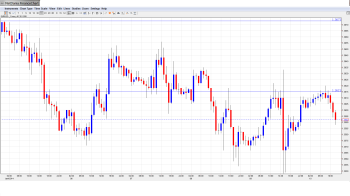EUR/USD is steady in Friday trading, with the pair trading just above the 1.36 line in what has been an uneventful week. In the Eurozone, French Industrial Production gained 1.3%, reversing directions after two straight declines. Eurozone Final GDP did not impress, with a paltry gain of 0.1%. In the US, today’s highlight is the Non-Farm Employment Change. On Thursday, the ECB maintained interest rates at 0.25%. US Unemployment Claims posted another strong reading and beat the estimate.
Here is a quick update on the technical situation, indicators, and market sentiment that moves euro/dollar.
EUR/USD Technical
- EUR/USD showed little movement in the Asian session, consolidating at 1.3613. The pair is unchanged in the European session.
Current range: 1.3525 to 1.3615.
Further levels in both directions:
- Below: 1.3525, 1.3440, 1.34, 1.3320, 1.3240 and 1.3175.
- Above: 1.3615, 1.3675, 1.3710, 1.3800, 1.3832, 1.3940 and 1.4036.
- 1.3615 is under strong pressure. 1.3675 follows.
- 1.3525 is providing strong support.
EUR/USD Fundamentals
- 7:45 French Industrial Production. Exp. 0.6%. Actual 1.3%.
- 10:00 Eurozone Final GDP. Exp. 0.3%. Actual 0.1%.
- 13:30 US Non-Farm Employment Change. Exp. 196K. See how to trade the NFP with EUR/USD.
- 13:30 US Unemployment Rate. Exp. 7.0%.
- 15:30 US Average Hourly Earnings. Exp. 0.2%.
- 15:00 US IBD/TIPP Economic Optimism. Exp. 45.3 points.
- 15:00 US Wholesale Inventories. Exp. 0.4%.
*All times are GMT
For more events and lines, see the Euro to dollar forecast.
EUR/USD Sentiment
- Markets Eye Non-Farm Payrolls: US Non-Farm Payrolls, one of the most important economic indicators, will be released later on Friday, and we could see some markets movement as a result. There had been concern that the indicator might sag towards the end of the year, but NFPs have looked strong. The past two readings have above the 200 thousand level and well above expectations. The markets are expecting another strong release, with the estimate standing at 196 thousand.
- ECB holds course: The first ECB rate announcement of 2014 was a non-event, as the central bank held the benchmark rate at a record low of 0.25%. Mario Draghi’s press conference did not make waves and move the currency markets, as has often been the case in the past. Draghi said that monetary policy will remain accommodative for as long as is needed to help the Eurozone economy recover, and that interest rates will likely remain at present or lower levels for the foreseeable future. If growth and inflation indicators continue to look weak, the ECB may have to take action at its next meeting in February.
- Strong start for US employment numbers: It’s been an excellent start for employment numbers in the new year. ADP Non-Farm Payrolls looked very sharp, as the key indicator climbed to 238 thousand, up from 215 thousand a month ago. This easily surpassed the estimate of 199 thousand. This was followed by another strong Unemployment Claims, which dipped to 330 thousand, beating the forecast. With another QE taper in January a strong possibility, every employment release will be under the market microscope and could impact on the currency markets.
- Euro hits early January storm: The euro has not had much to cheer about in 2014, as the common currency has lost close to two cents in the past week. Surprisingly, the currency hasn’t received a boost from recent Eurozone data, which has generally looked sharp. German and Eurozone retail sales jumped in December, and German Unemployment Change sparkled with a sharp drop. As well, recent Spanish numbers have impressed. At the same time, Italy and France are struggling, and inflation and growth in the bloc remain subdued.
- Dollar outlook for 2014: Many analysts see the dollar strengthening in 2014, but the euro is certainly expected to give a fight. Here is one outlook: 2014 – Conditional Dollar Strength.

